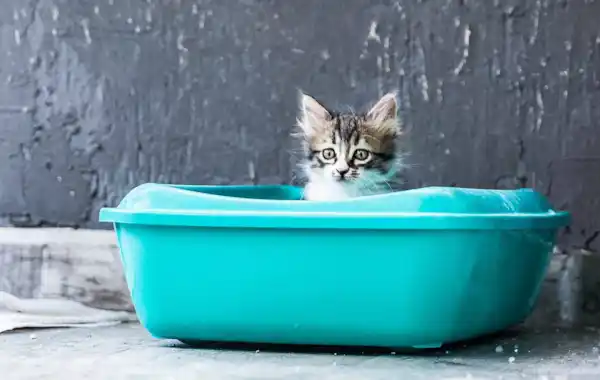Learning how to use the litter tray from a young age is an important part of feline development. Avoid accidents with our essential guide to how to litter train a kitten.
Most kittens learn to use their litter tray by watching their mother. However, kittens can sometimes house soil when they first arrive in their new home when given access to large, open spaces. Your kitten should ideally be confined to one room with his litter tray while he is initially settling in. When the kitten starts to explore the rest of his home, you can provide a few more litter trays so they are always easily accessible for the kitten
Provide your kitten with a few litter trays containing different litter substrates, for example, grit, wood and sandy litter. You can also provide the options of open and covered litter trays. By doing this your kitten will hopefully show you what litter substrate and litter tray type he likes. Also, your kitten may have a preference to wee in one litter tray and poo in another. Ensure the litter trays are kept in a quiet area, away from food and water bowls and always kept clean. Cats are particularly sensitive to bad smells that we might not even be aware of. It may be a case of trial and error to find a type of litter and location that he’s happy with.
As the kitten grows, the litter tray size needs to become bigger. If polythene tray liners are used they can sometimes catch in a kitten's claws and so it may be worth not using them to see if this makes a difference.
Learning how to litter train a kitten can be a time-consuming process but is essential in helping feline development and keeping your home clean and fresh.
Why does your kitten not use the litter tray?
There may be a number of reasons as to why your kitten won't use his litter tray. First ensure that the location of your litter tray is in a quiet space, and also that he can get in and out of his litter tray with ease.
Next you need to look at litter depth - cats usually prefer a deep quantity of litter. Hygiene and cleanliness are also important. Make sure that you have more than one litter tray for your cat. The rule is one tray for each cat plus an extra, the reason being that many cats are so fastidious they will not use a dirty tray a second time.
Many people don't keep trays clean enough. You need to scoop the soiled litter out as soon as it has been used and replace all of it at least once weekly. Make sure you don't leave it smelling strongly of disinfectant as this can also put cats off. Washing with a ten per cent solution of biological detergent, rinsing well with scalding water and drying thoroughly before refilling it is a good method.
If your cat is soiling somewhere in the house then you need to do something about this as soon as you can. If cats receive a scent message that says this is a latrine area, they will return to it over and over again. You can immediately help by sealing the area so that he cannot smell the scent. The best method for cleaning these areas is to use the ten per cent biological solution with kitchen paper and/or disposable cloths so that you don't just spread the smell around. Wash really well, rinse with clean water, dry and spray with surgical spirit (providing it will not harm the surface). When the surface and the underneath is dry, cover it with a plastic dust sheet and tape down the edges.
If your kitten is consistently missing the litter tray, or is messing elsewhere in the house, get your vet to check him out in case there’s an underlying health issue. Don’t tell him off — it could make the situation worse.
Top 10 tips on how to litter train a kitten

1. Provide one tray per cat, plus one extra.
2. Remove waste frequently and do a complete change at least once a week.
3. Position trays in quiet, private places away from other pets and noise.
4. Use a tray with lower sides for kittens and older cats.
5. Use the litter type that your kitten is used to (used in his breeder's or rescue home).
6. Fill the litter tray with enough litter for your cat to dig and bury his faeces.
7. Avoid cleaning trays with strong-smelling disinfectants and those containing phenol, which is toxic to cats.
8. Place your kitten in his tray every time he has eaten or woken up as this is when he's most likely to need to use it.
9. If you see your kitten sniffing at the floor, place him in the tray as it's likely he needs to 'go'.
10. If your kitten has an 'accident', mop or pick it up with a piece of tissue and then place it in the litter tray. Clean the soiled area thoroughly.








